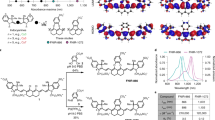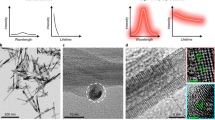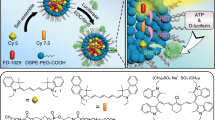Abstract
We have developed a method to image tumor-associated lysosomal protease activity in a xenograft mouse model in vivo using autoquenched near-infrared fluorescence (NIRF) probes. NIRF probes were bound to a long circulating graft copolymer consisting of poly-L-lysine and methoxypolyethylene glycol succinate. Following intravenous injection, the NIRF probe carrier accumulated in solid tumors due to its long circulation time and leakage through tumor neovasculature. Intratumoral NIRF signal was generated by lysosomal proteases in tumor cells that cleave the macromolecule, thereby releasing previously quenched fluorochrome. In vivo imaging showed a 12-fold increase in NIRF signal, allowing the detection of tumors with submillimeter-sized diameters. This strategy can be used to detect such early stage tumors in vivo and to probe for specific enzyme activity.
This is a preview of subscription content, access via your institution
Access options
Subscribe to this journal
Receive 12 print issues and online access
$209.00 per year
only $17.42 per issue
Buy this article
- Purchase on Springer Link
- Instant access to full article PDF
Prices may be subject to local taxes which are calculated during checkout




Similar content being viewed by others
References
Devita, V., Hellman, S. & Rosenberg, S. Cancer: Principles and Practice of Oncology (Lippincott, Philadelphia, PA, 1997).
Stocchi, L. & Nelson, H. Diagnostic and therapeutic applications of monoclonal antibodies in colorectal cancer. Dis. Colon. Rectum. 41, 232–250 ( 1998).
Kopans, D.B. Updated results of the trials of screening mammography. Surg. Oncol. Clin. N. Am. 6, 233–263 (1997).
Baum, R.P. & Brummendorf, T.H. Radioimmunolocalization of primary and metastatic breast cancer. Q. J. Nucl. Med. 42, 33–42 (1998).
Teates, C.D. & Parekh, J.S. New radiopharmaceuticals and new applications in medicine. Curr. Probl. Diagn. Radiol. 22, 229–266 (1993).
Dessureault, S. et al. Pre-operative assessment of axillary lymph node status in patients with breast adenocarcinoma using intravenous 99mtechnetium mAb-170H.82. Breast Cancer Res. Treat. 45, 29–37 (1997).
Pasqualini, R., Koivunen, E. & Ruoslahti, E. Alpha v integrins as receptors for tumor targeting by circulating ligands. Nat. Biotechnol. 15, 542–546 (1997).
Neri, D. et al. Targeting by affinity-matured recombinant antibody fragments on an angiogenesis associated fibronectin isoform. Nat. Biotechnol. 15 , 1271–1275 (1997).
Buchsbaum, D.J. Experimental tumor targeting with radiolabeled ligands. Cancer 80, 2371–2377 ( 1997).
Rusckowski, M., Qu, T., Chang, F. & Hnatowich, D.J. Technetium-99m labeled epidermal growth factor-tumor imaging in mice. J. Pept. Res. 50, 393–401 ( 1997).
Goodwin, D.A. & Meares, C.F. Pretargeting: general principles: October 10-12, 1996. Cancer 80, 2675– 2680 (1997).
Jain, R. Delivery of molecular medicine to solid tumors. Science 271, 1079–1080 (1996).
Muldoon, L.L. et al. Comparison of intracerebral inoculation and osmotic blood-brain barrier disruption for delivery of adenovirus, herpesvirus, and iron oxide particles to normal rat brain. Am. J. Pathol. 147, 1840–1851 (1995).
Roselli, M. et al. Systemic administration of recombinant interferon alfa in carcinoma patients upregulates the expression of the carcinoma-associated antigens tumor-associated glycoprotein-72 and carcinoembryonic antigen. J. Clin. Oncol. 14, 2031–2042 (1996).
Leto, G., Gebbia, N., Rausa, L. & Tumminello, F. Cathepsin D in the malignant progression of neoplastic diseases. Anticancer Res. 12, 235–240 ( 1992).
Keppler, D. et al. Tumor progression and angiogenesis: cathepsin B & Co. Biochem. Cell. Biol. 74, 799–810 (1996).
Kim, J., Yu, W., Kovalski, K. & Ossowski, L. Requirement for specific proteases in cancer cell intravasation as revealed by a novel semiquantitative PCR-based assay. Cell 94, 353– 362 (1998).
Callahan, R., Bogdanov, A., Fischman, A., Brady, T. & Weissleder, R. Preclinical evaluation and phase I clinical trial of a 99mTc labeled synthetic polymer used in blood pool imaging. AJR 171, 137–143 (1998).
Marecos, E., Weissleder, R. & Bogdanov, A., Jr. Antibody-mediated versus nontargeted delivery in a human small cell lung carcinoma model. Bioconjugate Chemistry 9, 184–191 ( 1998).
Quintart, J., Leroy-Houyet, M.A., Trouet, A. & Baudhuin, P. Endocytosis and chloroquine accumulation during the cell cycle of hepatoma cells in culture. J. Cell Biol. 82, 644– 653 (1979).
Liaudet, E., Derocq, D., Rochefort, H. & Garcia, M. Transfected cathepsin D stimulates high density cancer cell growth by inactivating secreted growth inhibitors. Cell Growth Differ. 6, 1045–1052 (1995).
Garcia, M. et al. Biological and clinical significance of cathepsin D in breast cancer metastasis. Stem Cells 14, 642–650 (1995).
Alfano, R.R. et al. Time-resolved and nonlinear optical imaging for medical applications. Ann. NY. Acad. Sci. 838, 14– 28 (1998).
Alfano, R., Demos, S. & SK, G. Advances in optical imaging of biomedical media. Ann. NY Acad. Sci. 820, 248–270 ( 1997).
Benaron, D.A., Cheong, W.F. & Stevenson, D.K. Tissue optics. Science 276, 2002–2003 (1997).
Hebden, J., Arridge, S. & Delpy, D. Optical imaging in medicine: I. experimental techniques. Phys. Med. Biol. 42, 825– 840 (1997).
Hebden, J.C. & Delpy, D.T. Diagnostic imaging with light. Br. J. Radiol. 70, S206–S214 (1997).
Benaron, D.A., Contag, P.R. & Contag, C.H. Imaging brain structure and function, infection and gene expression in the body using light. Philos. Trans. R. Soc. Lond. B. Biol. Sci. 352, 755–761 (1997).
Villringer, A. Functional neuroimaging. Optical approaches. Adv. Exp. Med. Biol. 413, 1–18 ( 1997).
Andersson-Engels, S., Klinteberg, C., Svanberg, K. & Svanberg, S. In vivo fluorescence imaging for tissue diagnostics. Phys. Med. Biol. 42, 815–824 ( 1997).
Manoharan, R. et al. Raman spectroscopy and fluorescence photon migration for breast cancer diagnosis and imaging. Photochem. Photobiol 67, 15–22 (1998).
Wu, J., Perelman, L., Dasari, R. & Feld, M. Fluorescence tomographic imaging in turbid media using early-arriving photons and Laplace transforms. Proc. Natl. Acad. Sci. USA 94, 8783– 8788 (1997).
Yavelow, J., Finlay, T.H., Kennedy, A.R. & Troll, W. Bowman-Birk soybean protease inhibitor as an anticarcinogen. Cancer Res. 43, 2454s–2459s ( 1983).
Yu, A.E., Hewitt, R.E., Connor, E.W. & Stetler-Stevenson, W.G. Matrix metalloproteinases. Novel targets for directed cancer therapy. Drugs & Aging 11, 229–244 (1997).
Wojtowicz-Praga, S.M., Dickson, R.B. & Hawkins, M.J. Matrix metalloproteinase inhibitors. Invest. New Drugs 15, 61–75 ( 1997).
Tamura, Y. et al. Highly selective and orally active inhibitors of type IV collagenase (MMP-9 and MMP-2): N-sulfonylamino acid derivatives. J. Med. Chem. 41, 640–649 (1998).
Kennedy, A.R. Cancer prevention by protease inhibitors. Prev. Med. 22, 796–811 (1993).
Giavazzi, R. et al. Batimastat, a synthetic inhibitor of matrix metalloproteinases, potentiates the antitumor activity of cisplatin in ovarian carcinoma xenografts. Clinical Cancer Research 4, 985–992 (1998).
Denis, L.J. & Verweij, J. Matrix metalloproteinase inhibitors: present achievements and future prospects. Invest. New Drugs 15, 175–185 (1997).
Bogdanov, A.A. Jr., Martin, C., Bogdanova, A.V., Brady, T.J. & Weissleder, R. An adduct of cis-diamminedichloroplatinum(II) and poly(ethylene glycol)poly(L-lysine)-succinate: synthesis and cytotoxic properties. Bioconj. Chem. 7, 144–149 (1996).
Weissleder, R., Cheng, H., Marecos, E., Kwong, K. & Bogdanov, A. Non-invasive in vivo mapping of tumor vascular and interstitial volume fractions. Eur. J. Cancer 34, 1448 –1454 (1998).
Mitch, W. & Goldberg, A. Mechanism of muscle wasting. N. Engl. J. Med. 335, 1897–1905 (1996).
Tsurugi, K. & Ogata, K. Presence of a thiol protease in regenerating rat-liver nuclei. Partial purification and some properties. Eur. J. Biochem. 109, 9–15 ( 1980).
Hashida, S., Towatari, T., Kominami, E. & Katunuma, N. Inhibitions by E-64 derivatives of rat liver cathepsin B and cathepsin L in vitro and in vivo. J. Biochem. (Tokyo) 88, 1805–1811 (1980).
Barrett, A.J., Kembhavi, A.A. & Hanada, K. E-64 [L-trans-epoxysuccinyl-leucyl-amido(4-guanidino)butane] and related epoxides as inhibitors of cysteine proteinases. Acta Biol Med Ger 40, 1513–1517 (1981).
Shau, H. & Dawson, J.R. Regulation of human natural killing by lysosomotropic and thiol- reactive agents. Immunology 55, 647–654 (1985).
Harper, J.W., Hemmi, K. & Powers, J.C. Reaction of serine proteases with substituted isocoumarins: discovery of 3,4-dichloroisocoumarin, a new general mechanism based serine protease inhibitor. Biochemistry 24, 1831 –1841 (1985).
Hudig, D., Allison, N.J., Kam, C.M. & Powers, J.C. Selective isocoumarin serine protease inhibitors block RNK-16 lymphocyte granule-mediated cytolysis. Mol. Immunol. 26, 793– 798 (1989).
Powers, J.C. et al. Mechanism-based isocoumarin inhibitors for serine proteases: use of active site structure and substrate specificity in inhibitor design. J. Cell Biochem. 39, 33–46 (1989).
Tearney, G. et al. In vivo endoscopic optical biopsy with optical coherence tomography. Science 276, 2037–2039 (1997).
el-Shirbiny, A.M. Prostatic specific antigen. Adv. Clin. Chem. 31, 99–133 (1994).
Himelstein, B.P., Canete-Soler, R., Bernhard, E.J., Dilks, D.W. & Muschel, R.J. Metalloproteinases in tumor progression: the contribution of MMP-9. Invasion Metastasis 14, 246–258 (1994).
Rha, S.Y. et al. Different expression patterns of MMP-2 and MMP-9 in breast cancer. Oncology Reports 5, 875–879 (1998).
Berquin, I.M. & Sloane, B.F. Cathepsin B expression in human tumors. Adv. Exp. Med. Biol. 389, 281– 294 (1996).
Bogdanov, A., Weissleder, R. & Brady, T. Long-circulating blood pool imaging agents. Advanced Drug Delivery Reviews 16, 335– 348 (1995).
Acknowledgements
We thank Anna Moore for providing all cell cultures and Lee Josephson and Michael Feld for valuable discussion. This study was supported, in part, by RO1 CA74424-01.
Author information
Authors and Affiliations
Corresponding author
Rights and permissions
About this article
Cite this article
Weissleder, R., Tung, CH., Mahmood, U. et al. In vivo imaging of tumors with protease-activated near-infrared fluorescent probes. Nat Biotechnol 17, 375–378 (1999). https://doi.org/10.1038/7933
Received:
Accepted:
Issue Date:
DOI: https://doi.org/10.1038/7933
This article is cited by
-
Label-free detection of biomolecules using inductively coupled plasma mass spectrometry (ICP-MS)
Analytical and Bioanalytical Chemistry (2024)
-
Practical Guidance for Developing Small-Molecule Optical Probes for In Vivo Imaging
Molecular Imaging and Biology (2023)
-
Fluorescence lifetime of injected indocyanine green as a universal marker of solid tumours in patients
Nature Biomedical Engineering (2023)
-
Progress in Modeling Neural Tube Development and Defects by Organoid Reconstruction
Neuroscience Bulletin (2022)
-
Molecular fluorophores for in vivo bioimaging in the second near-infrared window
European Journal of Nuclear Medicine and Molecular Imaging (2022)



